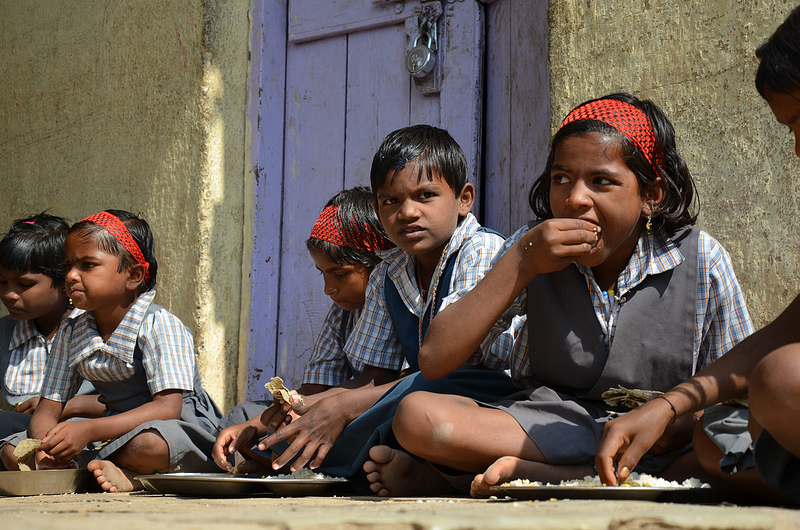Every third malnourished child in the world today lives in India. India’s Prime Minister, Mr. Manmohan Singh, is calling the country’s current malnutrition crisis “a national shame.” Acknowledging this grim reality, India’s political leaders and policymakers are beginning to adopt a multi-pronged strategy to tackle the problem of malnutrition. The Finance Minister of India announced an increase of over 20 percent in the agricultural budget for the year 2013-2014.
In a new initiative, the budget earmarked a large amount of money for exploring new agricultural technologies to achieve better nutrition. Many in the science and food policy establishment in India have started to believe that agriculture provides a route to solving India’s grave malnutrition problem. Several decades ago the “green revolution” helped alleviate the problem of food scarcity by introducing high-yielding varieties of wheat and rice.
Dr. M.S. Swaminathan, World Food Prize winner and the guru of the green revolution in India, believes that it is now time to address dietary quality. Millions of people do not get enough nutritious foods in their diets, especially foods that are rich in vitamins and minerals. Many of these foods, such as lentils, pulses, and leafy green vegetables, are too expensive for the poor. This is where biofortification comes in – the strategy of breeding essential vitamins and minerals (e.g. vitamin A, zinc, and iron) into staple food crops (such as rice or wheat) that people eat daily.
The recently released Indian budget (2013-2014) outlines a plan to develop Nutri-farms, where iron-rich pearl millet, zinc-rich rice and wheat, and protein-rich maize will be grown. These Nutri-farms will be piloted in the 200 districts in India that are most affected by malnutrition. Swaminathan said, “I was impressed with the announcement by the Indian Finance Minister to start, on a pilot scale, a major initiative for marrying nutrition and agriculture by establishing Nutri-farms.” Swaminathan also wrote an editorial on Nutri-farms and the increase in agricultural budget in The Hindu, a prominent newspaper in southern India. Swaminathan is convinced that all developing countries must embrace biofortification to improve nutrition across all demographics, but especially among the poor.
In a 2012 editorial in Science Magazine he wrote, “Efforts should be made by developing countries to make each family farm a biofortified farm.” HarvestPlus is an international program that leads a global effort in biofortification. HarvestPlus and its partners are developing more nutritious varieties of crops such as pearl millet, rice, and wheat, which are among the most widely consumed staple food crops in India. For example, HarvestPlus, in partnership with the International Crops Research Institute for the Semi-Arid Tropics (ICRISAT) and Nirmal Seeds Private Ltd, has developed, commercialized, and started disseminating high-iron pearl millet in India.
Howarth Bouis, the director of HarvestPlus, strongly believes that India’s efforts to fight malnutrition will be well served by strengthening the linkages between agriculture and nutrition. He says, “The allocation of funds equivalent to USD 40 million to develop farms growing micronutrient-rich crops reflects a welcome change of attitudes in India. The initial response to biofortification was lukewarm in India. But now India understands that biofortification is a good idea, and if India has the scientific know-how, public support for the idea, and necessary funding, HarvestPlus will be happy to stimulate research and provide any technical assistance that it can.”
Bouis was in India for a HarvestPlus symposium in New Delhi, “Improving Public Health through Biofortification.” The symposium was attended by many stakeholders, including scientists, government officials, policymakers, and NGOs, who addressed the status of biofortification projects underway in India. Senior government officials attending the meeting advised that different government departments are invested in the biofortification program to improve the nutritional health of the nation.
Others with a knowledge of the field mentioned that the initiative by HarvestPlus to launch iron-rich pearl millet in partnership with the private sector is progressing well. In an interview with an Indian journalist, Bouis highlighted the benefits of cultivating biofortified crops and how they can help improve nutrition. Bouis sees a great economic incentive and common sense reasoning in the pursuit of biofortified crops. He points out that the prices of almost all non-staple food groups rose over the past four decades.
Biofortified crops provide a low-cost solution in that context. He says, “It is the mineral- and vitamin-rich foods in the diet that have become ever-more expensive for the poor. And biofortification is one means for remedying these trends where the cost of iron, zinc, and vitamin A in diets has risen.” The Nutri-farms planned under the new budget initiative in India could potentially turn the corner in the nation’s malnutrition crisis.
Also see: Govt to link ‘bio-fortified’ crops to Food Security Mission
